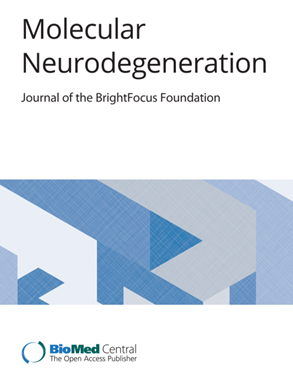Contribution of amyloid deposition from oligodendrocytes in a mouse model of Alzheimer’s disease
IF 14.9
1区 医学
Q1 NEUROSCIENCES
引用次数: 0
Abstract
The accumulation of β-amyloid (Aβ) peptides into insoluble plaques is an early pathological feature of Alzheimer’s disease (AD). BACE1 is the sole β-secretase for Aβ generation, making it an attractive therapeutic target for AD therapy. While BACE1 inhibitors have been shown to reduce Aβ levels in people with AD, clinical trials targeting BACE1 have failed due to unwanted synaptic deficits. Understanding the physiological role of BACE1 in individual cell types is essential for developing effective BACE inhibitors for the treatment of AD. Recent single-cell RNA transcriptomic assays revealed that oligodendrocytes are enriched with genes required for generating Aβ. However, the contribution of oligodendrocytes to amyloid plaque burden in AD and the side effects of oligodendrocyte-specific Bace1 deletion remain to be explored. We generated an oligodendrocyte-specific Bace1 knockout model (Bace1fl/fl;Olig2-Cre) to monitor potential disruptions in myelination using standard electron microscopy. Long-term potentiation (LTP) was monitored to measure synaptic integrity. We crossed the Bace1fl/fl;Olig2-Cre model with heterozygous AppNL−G−F/wt knock-in AD mice to generate AD mice lacking oligodendrocyte Bace1 (Bace1fl/fl;Olig2-Cre; AppNL−G−F/wt) and examined amyloid plaque number and insoluble Aβ levels and gliosis in these animals. Single nuclei RNA sequencing experiments were conducted to examine molecular changes in response to Bace1 deficiency in oligodendrocytes in the wild type or APP knock-in background. Bace1 deletion in oligodendrocytes caused no change in myelin thickness in the corpus callosum but a marginal reduction in myelin sheath thickness of the optic nerve. Synaptic strength measured by LTP was not different between Bace1fl/fl;Olig2-Cre and age-matched Bace1fl/fl control animals, suggesting no major effect on synaptic plasticity. Intriguingly, deletion of Bace1 in 12-month-old heterozygous AD knock-in mice (Bace1fl/fl;Olig2-Cre; AppNL−G−F/wt mice) caused a significant reduction of amyloid plaques by ~ 33% in the hippocampus and ~ 29% in the cortex compared to age-matched AD mice (Bace1fl/fl;AppNL−G−F/wt). Insoluble Aβ1–40 and Aβ1–42 levels were reduced comparably while more astrocytes and microglia were observed in surrounding amyloid plaques. Unbiased single-nuclei RNA sequencing results revealed that deletion of oligodendrocyte Bace1 in APPNL−G−F/wt knock-in mice increased expression of genes associated with Aβ generation and clearance such as ADAM10, Ano4, ApoE, Il33, and Sort1. Our results provide compelling evidence that the amyloidogenic pathway in oligodendrocytes contributes to Aβ plaque formation in the AD brain. While specifically targeting BACE1 inhibition in oligodendrocytes for reducing Aβ pathology in AD is likely challenging, this is a potentially explorable strategy in future studies.阿尔茨海默病小鼠模型中少突胶质细胞淀粉样蛋白沉积的贡献
β淀粉样蛋白(Aβ)肽累积成不溶性斑块是阿尔茨海默病(AD)的早期病理特征。BACE1是生成Aβ的唯一β分泌酶,因此成为治疗阿尔茨海默病的一个有吸引力的治疗靶点。虽然 BACE1 抑制剂已被证明能降低注意力缺失症患者体内的 Aβ 水平,但针对 BACE1 的临床试验却因不必要的突触缺陷而失败。要开发出治疗AD的有效BACE抑制剂,了解BACE1在不同细胞类型中的生理作用至关重要。最近的单细胞 RNA 转录组测定显示,少突胶质细胞富含生成 Aβ 所需的基因。然而,少突胶质细胞对AD淀粉样斑块负担的贡献以及少突胶质细胞特异性Bace1缺失的副作用仍有待探索。我们建立了一种少突胶质细胞特异性 Bace1 基因敲除模型(Bace1fl/fl;Olig2-Cre),利用标准电子显微镜监测髓鞘化的潜在破坏。通过监测长期电位(LTP)来衡量突触的完整性。我们将Bace1fl/fl;Olig2-Cre模型与杂合子AppNL-G-F/wt基因敲入型AD小鼠杂交,产生了缺乏少突胶质细胞Bace1的AD小鼠(Bace1fl/fl;Olig2-Cre; AppNL-G-F/wt),并检测了这些动物体内的淀粉样斑块数量、不溶性Aβ水平和胶质细胞病变。研究人员进行了单核 RNA 测序实验,以检测野生型或 APP 基因敲入背景的少突胶质细胞中 Bace1 缺失所引起的分子变化。在少突胶质细胞中缺失 Bace1 不会导致胼胝体的髓鞘厚度发生变化,但会使视神经的髓鞘厚度略有减少。通过LTP测量的突触强度在Bace1fl/fl;Olig2-Cre和年龄匹配的Bace1fl/fl对照组动物之间没有差异,表明对突触可塑性没有重大影响。耐人寻味的是,与年龄匹配的 AD 小鼠(Bace1fl/fl;Olig2-Cre; AppNL-G-F/wt)相比,在 12 个月大的杂合子 AD 基因敲入小鼠(Bace1fl/fl;Olig2-Cre; AppNL-G-F/wt 小鼠)中删除 Bace1 可使海马中的淀粉样蛋白斑块显著减少约 33%,使皮层中的淀粉样蛋白斑块显著减少约 29%。不溶性 Aβ1-40 和 Aβ1-42 水平也相应降低,同时在淀粉样斑块周围观察到更多的星形胶质细胞和小胶质细胞。无偏见的单核 RNA 测序结果显示,APPNL-G-F/wt 基因敲入小鼠中少突胶质细胞 Bace1 的缺失增加了与 Aβ 生成和清除相关的基因的表达,如 ADAM10、Ano4、ApoE、Il33 和 Sort1。我们的研究结果提供了令人信服的证据,证明少突胶质细胞中的淀粉样蛋白生成途径有助于AD大脑中Aβ斑块的形成。虽然特异性地靶向抑制少突胶质细胞中的 BACE1 以减少 AD 中 Aβ 的病理变化可能具有挑战性,但这是未来研究中一个潜在的可探索的策略。
本文章由计算机程序翻译,如有差异,请以英文原文为准。
求助全文
约1分钟内获得全文
求助全文
来源期刊

Molecular Neurodegeneration
医学-神经科学
CiteScore
23.00
自引率
4.60%
发文量
78
审稿时长
6-12 weeks
期刊介绍:
Molecular Neurodegeneration, an open-access, peer-reviewed journal, comprehensively covers neurodegeneration research at the molecular and cellular levels.
Neurodegenerative diseases, such as Alzheimer's, Parkinson's, Huntington's, and prion diseases, fall under its purview. These disorders, often linked to advanced aging and characterized by varying degrees of dementia, pose a significant public health concern with the growing aging population. Recent strides in understanding the molecular and cellular mechanisms of these neurodegenerative disorders offer valuable insights into their pathogenesis.
 求助内容:
求助内容: 应助结果提醒方式:
应助结果提醒方式:


